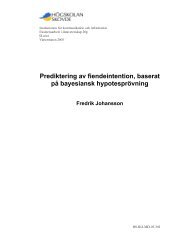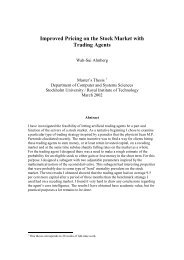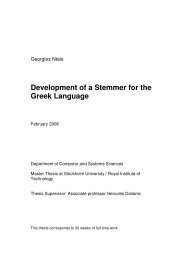Modeling Hydra Behavior Using Methods Founded in Behavior-Based Robotics
Modeling Hydra Behavior Using Methods Founded in ... - SAIS
Modeling Hydra Behavior Using Methods Founded in ... - SAIS
You also want an ePaper? Increase the reach of your titles
YUMPU automatically turns print PDFs into web optimized ePapers that Google loves.
42 Chapter 7. Results and discussiona random walk [66]. Jenn<strong>in</strong>gs used the results from Wagner’s experiments <strong>in</strong> his detaileddescription of spontaneous activities <strong>in</strong> <strong>Hydra</strong> [28].To <strong>in</strong>vestigate the spontaneous movement patterns of the modeled <strong>Hydra</strong>, simulationsof the animal <strong>in</strong> the absence of any external stimulus dur<strong>in</strong>g three days (72 hours) werecarried out. The foot position, (x f , y f ), of the simulated <strong>Hydra</strong> was recorded dur<strong>in</strong>g thistime. Evident from the implementation details of LPs, as stated <strong>in</strong> Section 6.1.1, the resultsagrees with Wagner’s study <strong>in</strong> the sense that <strong>Hydra</strong> moves about <strong>in</strong> a random walk.Additional test data would allow for an expansion of this experiment, as is discussed <strong>in</strong>Chapter 8. In the modeled <strong>Hydra</strong>, all locomotion steps are equally large, as discussed <strong>in</strong>Section 6.1.1. This differs from Wagner’s observations, <strong>in</strong> which the <strong>Hydra</strong> shows locomotionsteps of vary<strong>in</strong>g lengths. This limitation of the modeled <strong>Hydra</strong> is due to the simplificationsmade <strong>in</strong> the representation of the animal’s body, and a possible improvementis discussed <strong>in</strong> Chapter 8. The result from one realization of this simulation experiment isshown <strong>in</strong> Fig. 7.11.Figure 7.11: Position of <strong>Hydra</strong> dur<strong>in</strong>g three days of spontaneous activity.7.2.2 Experiment B: Effect of starvation on contraction frequencyIn [46], Passano and McCullough studied the effect of starvation on the contraction frequencyof <strong>Hydra</strong>. The average contraction rate of animals fed daily, as well as every third





